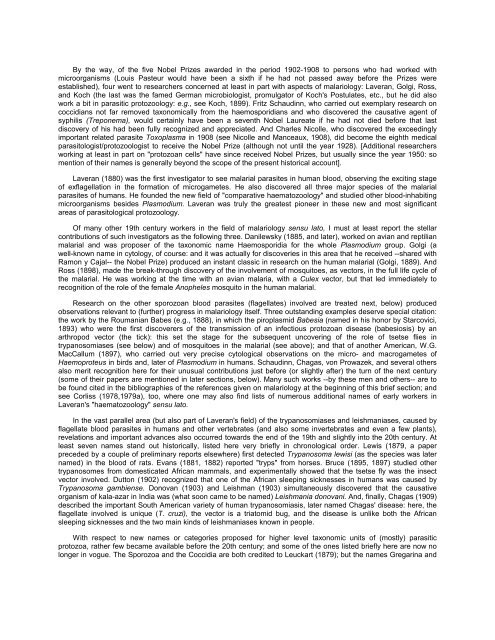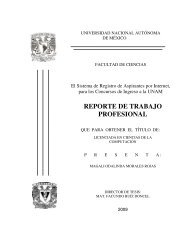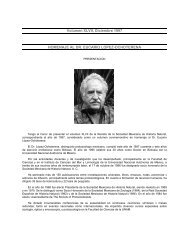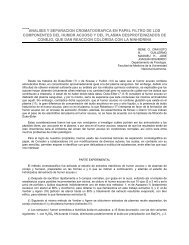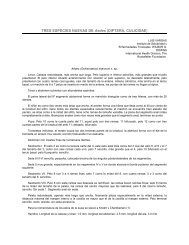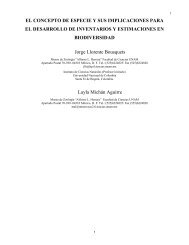Imprimiendo - Revista de la Sociedad Mexicana ... - Ciencias,UNAM
Imprimiendo - Revista de la Sociedad Mexicana ... - Ciencias,UNAM
Imprimiendo - Revista de la Sociedad Mexicana ... - Ciencias,UNAM
You also want an ePaper? Increase the reach of your titles
YUMPU automatically turns print PDFs into web optimized ePapers that Google loves.
By the way, of the five Nobel Prizes awar<strong>de</strong>d in the period 1902-1908 to persons who had worked withmicroorganisms (Louis Pasteur would have been a sixth if he had not passed away before the Prizes wereestablished), four went to researchers concerned at least in part with aspects of ma<strong>la</strong>riology: Laveran, Golgi, Ross,and Koch (the <strong>la</strong>st was the famed German microbiologist, promulgator of Koch's Postu<strong>la</strong>tes, etc., but he did alsowork a bit in parasitic protozoology: e.g., see Koch, 1899). Fritz Schaudinn, who carried out exemp<strong>la</strong>ry research oncoccidians not far removed taxonomically from the haemosporidians and who discovered the causative agent ofsyphilis (Treponema), would certainly have been a seventh Nobel Laureate if he had not died before that <strong>la</strong>stdiscovery of his had been fully recognized and appreciated. And Charles Nicolle, who discovered the exceedinglyimportant re<strong>la</strong>ted parasite Toxop<strong>la</strong>sma in 1908 (see Nicolle and Manceaux, 1908), did become the eighth medicalparasitologist/protozoologist to receive the Nobel Prize (although not until the year 1928). [Additional researchersworking at least in part on "protozoan cells" have since received Nobel Prizes, but usually since the year 1950: somention of their names is generally beyond the scope of the present historical account].Laveran (1880) was the first investigator to see ma<strong>la</strong>rial parasites in human blood, observing the exciting stageof exf<strong>la</strong>gel<strong>la</strong>tion in the formation of microgametes. He also discovered all three major species of the ma<strong>la</strong>rialparasites of humans. He foun<strong>de</strong>d the new field of "comparative haematozoology" and studied other blood-inhabitingmicroorganisms besi<strong>de</strong>s P<strong>la</strong>smodium. Laveran was truly the greatest pioneer in these new and most significantareas of parasitological protozoology.Of many other 19th century workers in the field of ma<strong>la</strong>riology sensu <strong>la</strong>to, I must at least report the stel<strong>la</strong>rcontributions of such investigators as the following three. Danilewsky (1885, and <strong>la</strong>ter), worked on avian and reptilianma<strong>la</strong>rial and was proposer of the taxonomic name Haemosporidia for the whole P<strong>la</strong>smodium group. Golgi (awell-known name in cytology, of course: and it was actually for discoveries in this area that he received --shared withRamon y Cajal-- the Nobel Prize) produced an instant c<strong>la</strong>ssic in research on the human ma<strong>la</strong>rial (Golgi, 1889). AndRoss (1898), ma<strong>de</strong> the break-through discovery of the involvement of mosquitoes, as vectors, in the full life cycle ofthe ma<strong>la</strong>rial. He was working at the time with an avian ma<strong>la</strong>ria, with a Culex vector, but that led immediately torecognition of the role of the female Anopheles mosquito in the human ma<strong>la</strong>rial.Research on the other sporozoan blood parasites (f<strong>la</strong>gel<strong>la</strong>tes) involved are treated next, below) producedobservations relevant to (further) progress in ma<strong>la</strong>riology itself. Three outstanding examples <strong>de</strong>serve special citation:the work by the Roumanian Babes (e.g., 1888), in which the pirop<strong>la</strong>smid Babesia (named in his honor by Starcovici,1893) who were the first discoverers of the transmission of an infectious protozoan disease (babesiosis) by anarthropod vector (the tick): this set the stage for the subsequent uncovering of the role of tsetse flies intrypanosomiases (see below) and of mosquitoes in the ma<strong>la</strong>rial (see above); and that of another American, W.G.MacCallum (1897), who carried out very precise cytological observations on the micro- and macrogametes ofHaemoproteus in birds and, <strong>la</strong>ter of P<strong>la</strong>smodium in humans. Schaudinn, Chagas, von Prowazek, and several othersalso merit recognition here for their unusual contributions just before (or slightly after) the turn of the next century(some of their papers are mentioned in <strong>la</strong>ter sections, below). Many such works --by these men and others-- are tobe found cited in the bibliographies of the references given on ma<strong>la</strong>riology at the beginning of this brief section; andsee Corliss (1978,1979a), too, where one may also find lists of numerous additional names of early workers inLaveran's "haematozoology" sensu <strong>la</strong>to.In the vast parallel area (but also part of Laveran's field) of the trypanosomiases and leishmaniases, caused byf<strong>la</strong>gel<strong>la</strong>te blood parasites in humans and other vertebrates (and also some invertebrates and even a few p<strong>la</strong>nts),reve<strong>la</strong>tions and important advances also occurred towards the end of the 19th and slightly into the 20th century. Atleast seven names stand out historically, listed here very briefly in chronological or<strong>de</strong>r. Lewis (1879, a paperprece<strong>de</strong>d by a couple of preliminary reports elsewhere) first <strong>de</strong>tected Trypanosoma lewisi (as the species was <strong>la</strong>ternamed) in the blood of rats. Evans (1881, 1882) reported "tryps" from horses. Bruce (1895, 1897) studied othertrypanosomes from domesticated African mammals, and experimentally showed that the tsetse fly was the insectvector involved. Dutton (1902) recognized that one of the African sleeping sicknesses in humans was caused byTrypanosoma gambiense. Donovan (1903) and Leishman (1903) simultaneously discovered that the causativeorganism of ka<strong>la</strong>-azar in India was (what soon came to be named) Leishmania donovani. And, finally, Chagas (1909)<strong>de</strong>scribed the important South American variety of human trypanosomiasis, <strong>la</strong>ter named Chagas' disease: here, thef<strong>la</strong>gel<strong>la</strong>te involved is unique (T. cruzi), the vector is a triatomid bug, and the disease is unlike both the Africansleeping sicknesses and the two main kinds of leishmaniases known in people.With respect to new names or categories proposed for higher level taxonomic units of (mostly) parasiticprotozoa, rather few became avai<strong>la</strong>ble before the 20th century; and some of the ones listed briefly here are now nolonger in vogue. The Sporozoa and the Coccidia are both credited to Leuckart (1879); but the names Gregarina and


